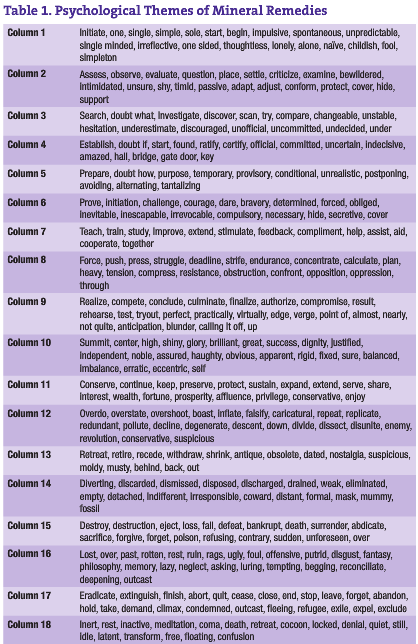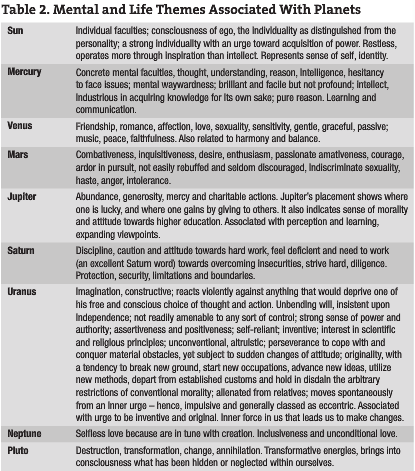Related? The Periodic Table, Planets of the Solar System and Homeopathic Medicine
Ameet Aggarwal, ND
This article will investigate the mental/emotional properties of homeopathic remedies made of minerals and elements and the emotional characteristics of the planets in astrology, and explore how there may be a direct correlation between the planets of our solar system and the periodic table.
Homeopathic Use of the Periodic Table
Mineral remedies are comprised of various elements found in the periodic table. For example, Ferrum metallicum is a homeopathic remedy made of iron, Mag-Phos is a remedy made of magnesium and phosphorus, and so on. There are experts in homeopathy who have managed to group mineral remedies according to the psychological themes that they manifest in people. For example, there are a group of mineral remedies associated with relationship issues, others with depression, fear, family issues, childhood or developmental issues, etc. Renowned homeopaths Jan Scholten and Rajan Sankaran have managed to categorize the emotional and psychological themes of remedies based on their row and column position within the periodic table.
 Table 1 consists of words that describe the psychological themes of mineral remedies within the periodic table. They are categorized according to the column of the periodic table that they fall into.
Table 1 consists of words that describe the psychological themes of mineral remedies within the periodic table. They are categorized according to the column of the periodic table that they fall into.
The Periodic Table and Astrology
Now that we have seen psychological and life themes within the periodic table, we will examine similar themes of planets according to astrology. In astrology, the planets exert certain influences on people, depending on their position in the heavens relative to the individual’s date and time of birth.
Table 2 consists of terms associated with the mental and life themes associated with the planets.
Notice the correlation in themes between those of the periodic table and those of the planets. Even though there is a loose correlation, there appears to be some similarity. Most notably, the following columns of the periodic table have similarities to the following planets:
- Column 1 – Sun
- Column 2 – Mercury
- Column 6 – Mars
- Column 7 – Jupiter
- Column 8 – Saturn
- Column 10 – Uranus
- Column 15 – Pluto
 Certainly, there are missing pieces to this relationship; not all columns and planets have definite associations, and a lot more work needs to be done to find all the links. The intriguing part of this correlation is that as we move towards the right in the periodic table, we also move according to the way the planets are distanced from the sun. This is no surprise, however, because as we move towards the right in the periodic table, the number of electrons in the outer orbit around an atom’s nucleus also increases which, with a little stretch of the imagination, somewhat reflects the increasing number of planets that orbit the sun as we move further from the sun. This possibility is in harmony with the theory that the microcosm of the universe is reflected in the bigger macrocosm of the universe and vice versa. Hence, it is fair to assume that the atomic structure and arrangements of elements in the periodic table have some reflection on the way our planets behave in the solar system.
Certainly, there are missing pieces to this relationship; not all columns and planets have definite associations, and a lot more work needs to be done to find all the links. The intriguing part of this correlation is that as we move towards the right in the periodic table, we also move according to the way the planets are distanced from the sun. This is no surprise, however, because as we move towards the right in the periodic table, the number of electrons in the outer orbit around an atom’s nucleus also increases which, with a little stretch of the imagination, somewhat reflects the increasing number of planets that orbit the sun as we move further from the sun. This possibility is in harmony with the theory that the microcosm of the universe is reflected in the bigger macrocosm of the universe and vice versa. Hence, it is fair to assume that the atomic structure and arrangements of elements in the periodic table have some reflection on the way our planets behave in the solar system.
What Could This Mean for NDs?
There are many new fields of thought that can emerge from this hypothesis, including:
- Each element of the periodic table is representative of a planet’s particular position in the solar system or, astrologically speaking, the elements can be linked to a planet’s position within an astrological “house.”
- If the microcosm-macrocosm theory holds strength, scientists can measure aspects of the universe using various characteristics of atoms in the periodic table, such as the distance of electrons from the atoms and the atomic weight of one atom relative to another. Gravitational influences in the universe can also be studied by looking at the pull within the atomic nucleus, or the pull the atomic nucleus has on the orbiting electrons. The arrangement of the universe could be observed by observing the arrangement of atoms in the periodic table.
- Theories can emerge about the manifestation of matter during the big bang and the expansion of the universe, depending on where atoms/elements are located in the periodic table. Perhaps different elements emerged at different times during the evolution of the universe. Perhaps the elements were formed in some order that is reflected by where they are in the periodic table.
- The periodic table may be able to be restructured to closely match the way the solar system exists.
- Measuring the relative center of the universe, depending on what studies emerge on how the atoms represent the position of planets and stars or solar systems or even galaxies.
- Theories can emerge about the type of elements that exist in different galaxies based on their relative size or a combination of planets/stars that exist in them.
- For doctors who practice homeopathy, finding the right remedy for a patient may be possible by examining his or her astrological chart.
- Homeopathic remedies are formed from plant, animal and mineral sources. If certain plant or animal remedies have similar actions as mineral remedies, is there a scientific correlation between planets and these other forms of nature?
The list can go on and on. It is for interested scientists, doctors practicing homeopathy, and astrologers to bring this information closer together, and to find a correlation that may explain a tremendous amount about our universe.
 Ameet Aggarwal, ND is a graduate of CCNM. He did his post-graduate work in Gestalt psychotherapy at the Gestalt Institute of Toronto. He is the founder and executive director of The Foundation for Integrated Medicine in Africa (FIMA), www.FimAfrica.Org, a registered charitable organization delivering integrated medicine to remote villages in Northern Kenya. Currently he is in Kenya, finding ways to bring funding to FIMA’s mobile clinics.
Ameet Aggarwal, ND is a graduate of CCNM. He did his post-graduate work in Gestalt psychotherapy at the Gestalt Institute of Toronto. He is the founder and executive director of The Foundation for Integrated Medicine in Africa (FIMA), www.FimAfrica.Org, a registered charitable organization delivering integrated medicine to remote villages in Northern Kenya. Currently he is in Kenya, finding ways to bring funding to FIMA’s mobile clinics.
Resources
- Planetary Psychology. AstrologyWeekly, www.astrologyweekly.com/dictionary/planetary-psychology.php; retrieved April 19, 2008.
- My Book, Chapter 2 – The Planets. LiveJournal, http://community.livejournal.com/astrology/2250514.html; retrieved April 19, 2008.










